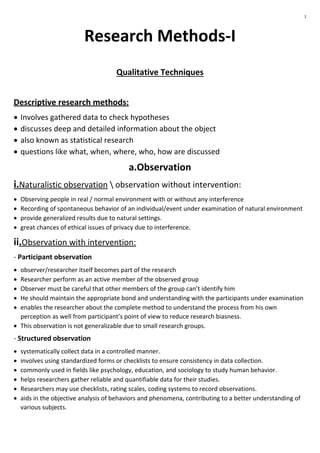
Research Methods 1 lectures.docx
- 1. 1 Research Methods-I Qualitative Techniques Descriptive research methods: Involves gathered data to check hypotheses discusses deep and detailed information about the object also known as statistical research questions like what, when, where, who, how are discussed a.Observation i.Naturalistic observation observation without intervention: Observing people in real / normal environment with or without any interference Recording of spontaneous behavior of an individual/event under examination of natural environment provide generalized results due to natural settings. great chances of ethical issues of privacy due to interference. ii.Observation with intervention: - Participant observation observer/researcher itself becomes part of the research Researcher perform as an active member of the observed group Observer must be careful that other members of the group can’t identify him He should maintain the appropriate bond and understanding with the participants under examination enables the researcher about the complete method to understand the process from his own perception as well from participant’s point of view to reduce research biasness. This observation is not generalizable due to small research groups. - Structured observation systematically collect data in a controlled manner. involves using standardized forms or checklists to ensure consistency in data collection. commonly used in fields like psychology, education, and sociology to study human behavior. helps researchers gather reliable and quantifiable data for their studies. Researchers may use checklists, rating scales, coding systems to record observations. aids in the objective analysis of behaviors and phenomena, contributing to a better understanding of various subjects.
- 2. 2 - Field experiments Performed in natural settings: schools, industries, hospitals. consumes more time To know whether classroom learning or open environment learning is more appropriate teaching method for students then researcher will recommend this method. iii.Recording behavior: - Qualitative measures of behavior - Quantitative measures of behavior Aspect Qualitative Measures of Behavior Quantitative Measures of Behavior Nature of Data non-numeric data Descriptive Numeric measurable data Data Type Subjective based on opinions & interpretations Objective based on counts, measurements or scales Examples Observations Interviews open-ended survey responses Counts Frequencies Scores Ratings measurements Precision Less precise and standardized More precise and standardized Data Analysis Involves coding, categorizing, and interpreting text or observations Involves statistical analysis, calculations, and numerical comparisons Use in Research Useful when exploring new or complex phenomena, providing insights and depth Suitable for hypothesis testing, comparisons, and statistical modeling Deals with Characteristics attributes Amounts numerical values Research Fields Commonly used in social sciences humanities ethnographic studies Commonly used in natural sciences psychology economics iv. Analysis of observational data Advantages, problems & methodological issues
- 3. 3 b. Unobtrusive measures of behavior - Physical traces - Archival data Aspect Physical traces Archival data Nature of Data Tangible tangible remnants or artifacts left behind by human actions Recorded information stored in documents, records, or databases source Directly observable physical artifacts, such as footprints, graffiti, or tools Pre-existing records or documents created for various purposes collection Requires on-site observation and physical examination Requires access to existing archives, libraries, or databases Temporal Characteristics Typically reflects past actions and behaviors in a specific time and place Can cover a wide range of time periods, from historical records to recent data Data type Often qualitative or semi- quantitative, describing the nature of physical traces Can be both qualitative and quantitative, depending on the content Research application Useful for reconstructing past events, understanding ancient cultures, or forensic investigations Valuable for historical research, social studies, policy analysis, and trend analysis Preservation and Accessibility May deteriorate over time and require preservation efforts Typically stored and maintained for long-term accessibility Examples Footprints, archaeological artifacts, graffiti, broken glass at a crime scene Historical documents, census records, newspaper archives, digital logs
- 4. 4 importance of research methods in psychology 1. Understanding Behavior: Research methods help psychologists figure out why people do the things they do. 2. Evidenced Answers: They provide evidence-based answers to questions about the mind and behavior. 3. Improving Lives: Research helps develop better therapies and treatments for mental health. 4. Avoiding Assumptions: It stops us from making guesses about human behavior without proof. 5. Testing Hypotheses: Research methods let us test our ideas and see if they're true. 6. Learning from the Past: We learn from past research to build on our knowledge. 7. Validating Theories: They help validate and refine psychological theories for a better understanding of the mind. Aspect Stratified Random Sampling Snowball Sampling Purpose To ensure representation from different subgroups in the population. To study hard-to-reach or hidden populations where no clear sampling frame exists. Method Divide the population into distinct subgroups (strata) based on specific characteristics ( age, gender, income). Start with a few participants who meet your criteria (seed participants). Ask them to refer others who also fit the criteria. Selection Process Randomly select samples from each stratum in proportion to their size in the population. Participants recruit more participants, creating a "snowball" effect. Use Useful when you want to make sure each subgroup is adequately represented in your study. Helpful when researching sensitive or marginalized groups where traditional sampling methods are challenging. Example If you're studying opinions on a political issue, you might stratify by age groups to get a balanced view across generations. If you're studying the experiences of drug users in a specific community, you might start with one known user and ask them to introduce you to others in their network.